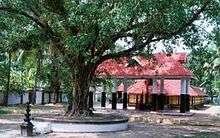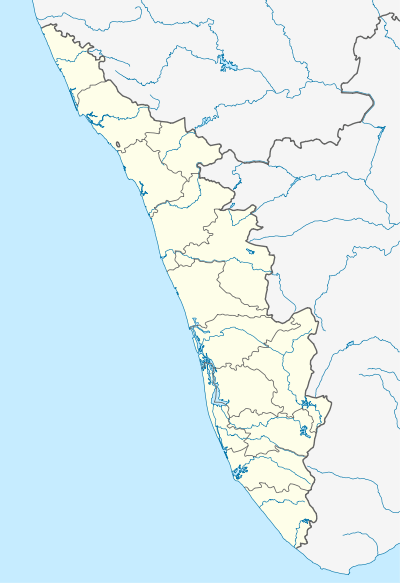Thamaramkulangara Sree Dharma Sastha Temple
| Thamaramkulangara Sree Dharma Sastha Temple | |
|---|---|
 Swami Saranam | |
 Location in Kerala | |
| Geography | |
| Coordinates | 9°57′6″N 76°20′19″E / 9.95167°N 76.33861°ECoordinates: 9°57′6″N 76°20′19″E / 9.95167°N 76.33861°E |
| Country | India |
| State | Kerala |
| Location | Tripunithura, Kochi |
| Culture | |
| Sanctum | Lord Ayyappa |
| Architecture | |
| Architecture | Kerala |
| History | |
| Date built | Unknown |
Thamaramkulangara Sree Dharma Sastha temple (Malayalam: താമരംകുളങ്ങര ശ്രി ധര്മശാസ്താ ക്ഷേത്രം) is one of the most prominent temple in Tripunithura, Kochi in the state of Kerala. It is dedicated to Lord Ayyappa worshiped as Dharmasastha.
Origin
According to anecdotes Lord Dharma Sastha of Chamravattom (in Malappuram District) followed one of his priests from Morakkala Mana who had shifted to Tripunithura. Lord Dharma Sastha assumed the form of a lizard and came with the priest comfortably by sitting on his traditional umbrella made up of palm leaves. Since then Lord Ayyappa is worshiped here bringing prosperity to the place.[1]
History
The temple was initially owned by Morakkala Mana, but the prosperity of family was challenged and the day-to-day affairs were in question. The high priest finally approached the Maharajah of Cochin and handed the temple over to him in the 1930s. The King ordered the renovation of the temple and the Nithya Nidhanam (daily pooja) was funded by Nadumittom Devasom. This state of affairs continued with minor changes until the Fall of the Kingdoms when India got Independence. Again the temple affairs was in disarray.
In 1953 the youth in and around the temple came together for the betterment of the temple, precincts and restart the temple festival. This movement strengthened up with time, involving in many activities. These people in 1963 formed the Thamaramkulangara Ayyapa Seva Samithy (TASS). TASS spearheaded a development campaign which drove a dramatic rise of the temple from obscurity to center stage of temple landscape in Ernakulam. In 1984 with others, the temple was transferred to Kerala Uranma Devaswom Board.

Upadevathas
Besides Dharmasastha devotees also worship Lord Ganesha and Bhadrakali along with Nagaraja and Brahmasrakshas. Separate rituals and pooja is performed as required to these Upadevathas also.
Thamaramkulangara Ayyappa Seva Samithy (TASS)
Though the temple is owned by Uranma Devaswom Board, virtually all the affairs are managed by Thamaramkulangara Ayyappa Seva Samithy (TASS), a voluntary organization led by local people. TASS is also deeply involved in nurturing and popularising the temple culture by organizing events stretching the full cultural spectrum from Bhajan Sandhya to Chakyar Koothu, music concerts to ensemble of percussion instruments, etc. TASS is involved in social activities and celebrations like blood donation camps, awarding bright students, etc.
Makaravilakku
Makaravilakku, the annual festival of this temple, bears a unique status. It occurs in January. As per the Malayalam era, the first day of the Makaram Month is celebrated as the Makaravilakku in the temple. Thamaramkulangara Ayyappa Seva Samithy organises the events of Makaravilakku in a way to keep the holiness of the temple precincts. The six days of celebrations begins with the Holy Flag hoisting (Kodiyettam) by chief priest (Thantri) five days before the Makaravilakku day.
Festivals
Thamaramkulangara Sree Dharmasastha temple celebrates many festivals apart from Makaravilakku. Some of them are:[2]
- Dwaja Prathishta Dinam is the anniversary of the erection of the Holy Flag Post (Kodimaram) in the temple. It is celebrated every year on Meenam 14th as per Malayalam calendar.
- Painguni Uthram is the birthday of Lord Sree Dharmasastha. Uthram star in the month of Meenam, as per Malayalam era is celebrated as Painguni Uthram.
- Vishu is celebrated on the first day of Medam as per Malayalam Calendar. This year it will be celebrated on Friday,14 April by conducting Maha Ganapathy Homam.
- The temple is decorated with flowers and traditional oil lamps in the last day of the Karkidakam month of the Malayalam calendar. This day is celebrated as the Karkidaka Niramala.
- Navarathri is celebrated in the temple on the Durgashtami, Mahanavami and Vijayadasami day every year with cultural programmes that cultivates Bhakthi in the temple precincts and Vidyarambham is performed in the temple on VijayaDasami day. It is considered to be very auspicious to have Vidyarambham in front of Lord Sree Dharmasastha.
- Mandalavilakku is celebrated on the 41st day of the Mandalakaalam. Mandalakaalam begins on the first day of Vrischikam. This signifies the end of Mandala Vratham, a mandatory prerequisite to visit the sacred Lord Ayyappa temple at Sabarimala.
Sasthaam Paattu is a traditional art form found in the central Kerala. It is also known as Ayyappan Paattu. It is a musical art form in which a team of people sing, songs praising Lord Ayyappa by playing a unique percussion instrument called 'Udukku'. The main attraction among the songs is the song that describes the birth of Lord Ayyappa.
In Thamaramkulangara, Sasthaam Paattu is performed on the first Saturday of Vrischikam as per the Malayalam era. In the noon of same day, Annadhaanam is performed by devotees and TASS volunteers to all the devotees, which has a unique menu and is popular.
Renovation
Renovation projects are going on in the temple. Several crucial checkpoints that have been successfully met:
- Brass covering of Sopanam steps and doors.
- Copper roofing of the sanctum sanctorum of Lord Ayyappa.
- Copper roofing of the sanctum sanctorum of Bhadrakali.
- Copper roofing of Namaskara Mandapam and outer structure or "Chuttambalam".
- Construction of "Pradakshina Vazhi" with granite stones.
- Purchasing of land behind the temple.
- Ootupura (multi-purpose building) constructed providing a common space for conducive and spiritually stimulating community activities.
Daily rituals
| Rituals | Time(IST) |
|---|---|
| Nirmalya Darsanam | 05:00 |
| Ethrutha Pooja | 07:15 |
| Nivedyam | 09:15 |
| Prasanna Pooja | 09:30 |
| Temple Closes | 10:00 |
| Temple Opens | 17:15 |
| Deeparadhana | 18:45 |
| Atthazha Pooja | 19:40 |
| Harivarasanam | 19:55 |
| Temple Closes | 20:00 |
References
- ↑ From articles of Makara Jyothi
- ↑ From http://thamara.net , the official website
- ↑ From http://thamara.net, the official website